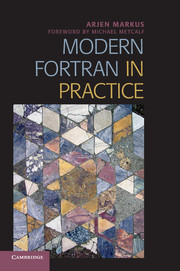Book contents
- Frontmatter
- Contents
- Foreword
- Preface
- 1 Introduction to Modern Fortran
- 2 Array-Valued Functions
- 3 Mathematical Abstractions
- 4 Memory Management
- 5 An Interface Problem
- 6 Interfacing to C: SQLite As an Example
- 7 Graphics, GUIs, and the Internet
- 8 Unit Testing
- 9 Code Reviews
- 10 Robust Implementation of Several Simple Algorithms
- 11 Object-Oriented Programming
- 12 Parallel Programming
- A Tools for Development and Maintenance
- B Caveats
- C Trademarks
- Bibliography
- Index
Foreword
Published online by Cambridge University Press: 05 July 2012
- Frontmatter
- Contents
- Foreword
- Preface
- 1 Introduction to Modern Fortran
- 2 Array-Valued Functions
- 3 Mathematical Abstractions
- 4 Memory Management
- 5 An Interface Problem
- 6 Interfacing to C: SQLite As an Example
- 7 Graphics, GUIs, and the Internet
- 8 Unit Testing
- 9 Code Reviews
- 10 Robust Implementation of Several Simple Algorithms
- 11 Object-Oriented Programming
- 12 Parallel Programming
- A Tools for Development and Maintenance
- B Caveats
- C Trademarks
- Bibliography
- Index
Summary
The applications of Fortran span, very nearly, the whole period during which computers have been in general-purpose use. This is quite remarkable and, given the demise so many other high-level languages, it is quite difficult to know why. Possibly the original design concepts of John Backus – ease of use and efficiency of execution – have been two major factors. Another might be the devotion of Fortran's user community, who labor to keep it abreast of developments in programming techniques and to adapt it to ever-more demanding requirements.
Despite all the predictions, over several decades, that Fortran is about to become extinct, the language has shown itself to be remarkably resilient. Furthermore, over the last few years, it has been subject to new rounds of standardization, and the latest standard, Fortran 2008, should again extend the language's life. Against this background, it is very regrettable that old versions of Fortran live on, both in the form of antiquated courses given by incorrigible teachers and also as an outmoded concept in the minds of its detractors. After all, modern Fortran is a procedural, imperative, and compiled language with a syntax well suited to a direct representation of mathematical formulae. Its individual procedures may be compiled separately or grouped into modules, either way allowing the convenient construction of very large programs and procedure libraries. The language contains features for array processing, abstract data types, dynamic data structures, object-oriented programming, and parallel processing.
- Type
- Chapter
- Information
- Modern Fortran in Practice , pp. xi - xivPublisher: Cambridge University PressPrint publication year: 2012

